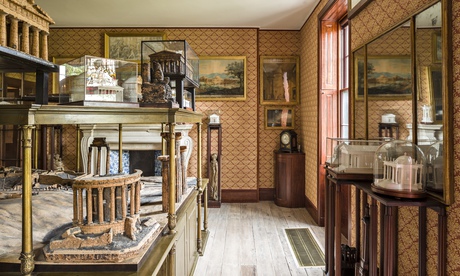The house and museum created by Sir John Soane in Lincoln’s Inn Fields, London is a universe whose contents approach the infinite. Loaded with the antiquities and artworks acquired by the great architect, both real and plaster-casts, its perspectives are then multiplied by mirrors and layers of space: a display case, as it might be, in a niche in a vestibule beyond a room reached from an ante-room framed by an arch. The exterior is largely screened off, a distant memory, or experienced through filtered and indirect light. The experience is of an internal world of unknown boundaries.
Should there be any danger of knowing it all, wormholes then open up into unsuspected galaxies, as previously inaccessible spaces are brought back to life by its ongoing restoration programme. The latest of these also gives a view into Soane’s bizarre mind. Ostensibly the top floor apartment for Soane and his wife, Eliza, it is also a shrine, a statement of architectural history, a bit of a Pharaonic tomb.
This is where Soane and Eliza slept and lived, as the house below them became engulfed with objects. The suite includes his and her bedrooms, a bathroom and her morning room, which she would occupy for only a few years until her death in 1815, which Soane blamed on the stress caused by their renegade and dissolute son George. Soane died in 1837 and for most of his remaining time he left her bedroom as a sort of memorial, until in 1834 it too succumbed to the objects. By then he had despaired of George (another son, the not much more satisfactory John, had died) and had decided that the house should be dedicated to the future instruction of architects. He cut out his own son in favour of a more generalised posterity.
Eliza’s bedroom became a model room, which is now the centrepiece of the reopened rooms. It is filled almost to its edges with a central installation of models of Pompeii, Paestum and other ancient sites. Some are in cork, a material that is good at looking crumbled and aged, and show the sites as ruins. Others are in crisp plaster-of-Paris and are conjectures as to what they might have been when new. A third type of model, in wood, shows Soane’s own buildings. The implication is that these are the equals of famous ancient buildings on show.
It is possible elsewhere in the museum, for all its marvels, to sense that Soane was strange – obsessive, controlling, introspective, morbid. In Eliza’s dressing room the feeling gets stronger. It has a blizzard of flat and convex mirrors which, while doing wonderful things to multiply the sense of space, feel like so many seeing eyes. Things get odder again with a cabinet in the model room, where a model showing the plan of Soane’s now-lost Westminster law courts is placed before an array of Egyptian, Hindu and classical deities.
In the bathroom you begin to wonder if George, when he challenged his father’s will on the grounds of insanity, had a case. His bath has been recreated, and its original wooden lid put on top. Why would a bath have a lid? Because late in life Soane decided to fill this and other containers with personal effects – spectacles, false teeth, documents – with the stipulation that they were not to be opened until the 50th anniversary of his wife’s death. It is not recorded what the architect did for personal hygiene, once he had made his tub into a Canopic jar of professional life.
In these rooms Soane’s ideas and passions are compressed with extraordinary density into a small space. Themes from the rest of the house and museum are found in darker and more intense form. There are those of time and mortality, embodied in the contrast of cork and plaster models, and the creation of little worlds, that look from one into another. The mirrors in Eliza’s dressing room have this effect, as do the many framed paintings that cover the walls. There is mystery, gloom, the dissolution of surfaces, complexity and surprise. The spatial richness of an emperor’s palace is compacted into a domestic interior.
The recovery of these rooms, by Julian Harrap architects, has required some reconstruction and re-creation of such things as the original wallpaper, and putting back a bit of the Pompeii model that had been lost. According to some theories of conservation this degree of replication is on the heavy side, but the end justifies the means. It brings to life an extraordinary creation by one of Britain’s most original architects and adjusts the perception of the rest of the house and museum, and of Soane’s other works.
Soane played a leading role in forming the modern idea of the architectural profession, which might seem like a sober enough activity. But if in the following two centuries that profession was sometimes prone to grandiosity as well as brilliance, or a quasi-spiritual belief in its own virtues, these attitudes’ antecedents can be found in some small rooms in the top of a house on Lincoln’s Inn Fields.











